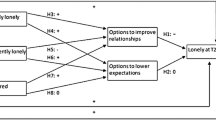Abstract
The purpose of this study was to compare the effects of two cognitive-behavioral interventions whose contents were matched to distinct types of loneliness (intimate and social) derived from empirical and theoretical literature and from a factor analysis of theRevised UCLA Loneliness Scale. Screened participants were assessed on measures varying in theoretical relevance to the treatment conditions. The hypotheses were that each treatment would favorably influence measures of high theoretical relevance (e.g., the social loneliness treatment would reflect changes on measures of social loneliness) and would have comparatively lesser effects on measures of lower theoretical relevance. Analysis of Covariance on pre-, post- and follow-up data indicated that the social loneliness treatment significantly decreased both intimate and social loneliness in the absence of differences on control variables. Issues relevant to the construct validity of the distinct treatments are discussed.
Similar content being viewed by others
References
Anderson, C. A., & Arnoult, L. H. (1985). Attributional style and everyday problems in living: Depression, loneliness, and shyness.Social Cognition, 3(1), 16–35.
Austin, B. A. (1983). Factorial structure of the UCLA loneliness scale.Psychological Reports, 53, 883–889.
Berzon, B., & Reisel, J. (1968).Encountertapes for Personal Growth Groups. Atlanta: Bell & Howell.
Borkovec, T. D., & Nau, S. D. (1972). Credibility of analog therapy rationales.Journal of Behavior Therapy and Experimental Psychiatry, 3, 258.
Campbell D. T., & Fiske, D. W. (1959). Convergent and discriminant validation by the multitrait-multimethod matrix.Psychological Bulletin, 56, 81–105.
Cohen, J. (1988).Statistical Power Analysis for the Behavioral Sciences (2d. ed.). Hillsdale, NJ: Lawrence Erlbaum.
Cook, T. D., & Campbell, D. T. (1979).Quasi-experimentation: Design and Analysis Issues for Field Settings. Chicago: Rand McNally.
Corrigan, J. D., & Schmidt, L. D. (1983). Development and validation of revisions in the Counselor Rating Form.Journal of Counseling Psychology, 30, 64–75.
de Jong-Gierveld, J. (1987). Developing and testing a model of loneliness.Journal of Personality and Social Psychology, 53(1), 119–128. AN: 74–34432.
Hausman, M. S. (1983). A comparison of cognitive-behavioral and social skills approaches in the treatment of loneliness (Doctoral dissertation, Southern Illinois University at Carbondale, 1983).Dissertation Abstracts International, 45, 1017B.
Hojat, H. (1982). Psychometric characteristics of the UCLA Loneliness Scale: A study with Iranian college students.Educational and Psychological Measurement, 42(3), 917–925.
Hojat, M., & Crandall, R. (Eds.). (1987). Loneliness: Theory, research, and applications.Special Issue of the Journal of Social Behavior and Personality. San Rafael, CA: Select Press.
Jones, W.H., Hobbs, S.A., & Hockenbury, D. (1982). Loneliness and social skill deficits.Journal of Personality and Social Psychology, 42, 682–689.
McWhirter, B. T. (1990a). Factor analysis of the revised UCLA Loneliness Scale.Current Psychology: Research and Reviews, 9(1), 56–68.
McWhirter, B. T. (1990b). Loneliness: A review of current literature with implications for counseling and research.Journal of Counseling and Development, 68(4), 417–422.
Peplau, L.A., Micheli, M., & Morasch, B. (1982). Loneliness and self-evaluation. In L. A. Peplau & D. Perlman (Eds.),Loneliness: A Sourcebook of Current Theory, Research and Therapy, (pp. 135–151). New York: Wiley.
Perlman, D., & Peplau, L.A. (1982). Theoretical approaches to loneliness. In L.A. Peplau & D. Perlman (Eds.),Loneliness: A Sourcebook of Current Theory, Research and Therapy, (pp. 123–134). New York: Wiley.
Orchard, J. M. (1986). The comparative effectiveness of social skill training and cognitive restructuring in the treatment of loneliness (Doctoral dissertation, University of Manitoba, 1986).Dissertation Abstracts International, 47, 2178B.
Richmond, L. J., & Picken, E. D. (1986). A model for working with lonely clients: Sadler revisited. In S.M. Natale (Ed.),Psychotherapy and the Lonely Patient, (pp. 109–120). New York: Haworth.
Rook, S. S. (1984). Research on social support, loneliness, and social isolation: Toward an integration.Review of Personality and Social Psychology, 5, 239–264.
Russell, D. (1982). The measurement of loneliness. In L.A. Peplau and D. Perlman (Eds.),Loneliness: A Sourcebook of Current Theory, Research and Therapy, (pp. 81–104). New York: Wiley.
Russell, D., Cutrona, C. E., Rose, J., & Yurko, K. (1984). Social and emotional loneliness: An examination of Weiss’s typology of loneliness.Journal of Personality and Social Psychology, 46(6), 1313–1321. AN: 71-28730.
Russell, D., Peplau, L. A., & Cutrona, C. E. (1980). The revised UCLA loneliness scale: Concurrent and discriminant validity evidence.Journal of Personality and Social Psychology, 39(3), 472–480.
Russell, D., Peplau, L. A., & Ferguson, M. (1978). Developing a measure of loneliness.Journal of Personality Assessment, 42, 290–294.
Schmidt, N., & Sermat, V. (1983). Measuring loneliness in different relationships.Journal of Personality and Social Psychology, 44(5), 1038–1047.
Schultz, N.R., & Moore, D. (1986). The loneliness experience of college students: Sex differences.Personality and Social Psychology Bulletin, 12(1), 111–119.
Snodgrass, M.A. (1987). The relationship of differential loneliness, intimacy, and characterological attributional style to duration of loneliness.Journal of Social Behavior and Personality, 2(2), 173–186.
Weiss, R. S. (Ed.) (1973).Loneliness: The Experience of Emotional and Social Isolation. Cambridge, Ma: MIT Press.
Weiss, R. S. (1987). Reflections on the present state of loneliness research.Journal of Social Behavior and Personality, 22, 1–16.
Young, J. E. (1982). Loneliness, depression and cognitive therapy: Theory and application. In L.A. Peplau & D. Perlman (Eds.),Loneliness: A Sourcebook of Current Theory, Research and Therapy, (pp. 379–406). New York: Wiley.
Zakahi, W. R., & Duran, R. L. (1982). All the lonely people: The relationship among loneliness, communicative competence, and communication anxiety.Communication Quarterly, 30, 203–209.
Author information
Authors and Affiliations
Additional information
This study was the recipient of the American College Personnel Association 1993–94 John Dallam Research Award. Preparation of this manuscript was supported in part by an American Psychological Association Dissertation Research Award, by the Sally M. Berridge Foundation, and by Southwest Gas Corporation.
Rights and permissions
About this article
Cite this article
McWhirter, B.T., Horan, J.J. Construct validity of cognitive-behavioral treatments for intimate and social loneliness. Current Psychology 15, 42–52 (1996). https://doi.org/10.1007/BF02686933
Accepted:
Issue Date:
DOI: https://doi.org/10.1007/BF02686933




